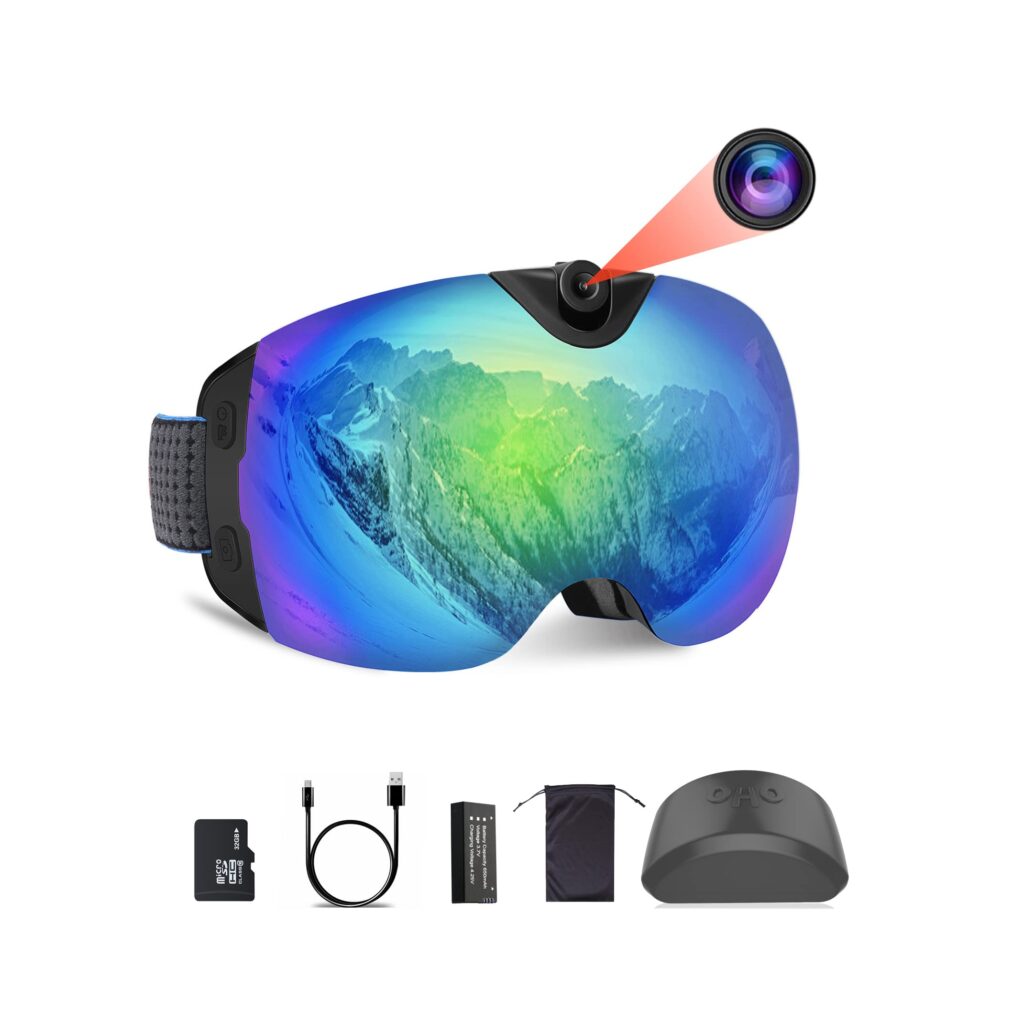Ski goggles fog up due to the temperature difference between the inside and outside of the goggles, combined with moisture and inadequate ventilation. Ski goggles are susceptible to fogging because of the warm air exhaled from your face, which gets trapped inside the goggles and condenses on the cold lens.
Additionally, if the goggles fit too snugly, they prevent adequate air circulation, leading to fogging. The fog reduces visibility, making it difficult to ski safely. Understanding the reasons behind goggle fogging can help skiers take preventive measures to ensure clear vision on the slopes.
We will explore the causes of foggy ski goggles and provide practical tips to minimize fogging, allowing for an enjoyable and safe skiing experience.
Table of Contents
ToggleThe Science Behind Foggy Ski Goggles
Have you ever wondered why your ski goggles fog up while out on the slopes? Understanding the science behind foggy ski goggles can help you find effective solutions to keep your vision clear. In this article, we will delve into the factors that contribute to fog formation and explore how temperature, humidity, body heat, and breath impact the fogging of ski goggles.
Explanation Of How Fog Forms On Ski Goggles
Before we explore the causes of foggy ski goggles, it’s important to understand how fog actually forms on the surface of the goggles. Fog is essentially tiny water droplets suspended in the air, created when warm, moist air cools down rapidly. When warm air comes into contact with a cooler surface, such as your goggles, it loses its ability to hold moisture, leading to condensation and the formation of fog.
Role Of Temperature And Humidity In Fog Formation
The temperature and humidity levels play a crucial role in the formation of fog on your ski goggles. When the outside temperature is cold and the air is humid, the risk of fogging increases significantly. Cold air has a lower capacity to hold moisture, causing the excess moisture to condense on the goggles, creating fog. Additionally, high humidity levels contribute to an increase in moisture content in the air, making fog formation even more likely.
In ski resorts that experience colder temperatures and higher humidity levels, such as those located in mountainous regions, the chances of goggles fogging up are greater. Conversely, in drier and less humid climates, fogging is less likely to occur due to the lower levels of moisture in the air.
Impact Of Body Heat And Breath On Fogging
As you engage in physical activity on the slopes, your body generates heat. This body heat, combined with the warm air exhaled from your breath, contributes to the fogging of your ski goggles. When warm air from your face escapes and comes into contact with the colder surface of the goggles, the moisture in the air condenses and forms fog on the lenses.
To minimize the impact of body heat and breath on fogging, it’s crucial to ensure proper ventilation and airflow inside your goggles. Goggles with vents or anti-fog coatings help to allow warm, moist air to escape and prevent it from reaching the lenses. By maximizing airflow and reducing the buildup of moisture, you can significantly reduce the occurrence of foggy ski goggles and maintain clear visibility while skiing or snowboarding.
Remember to choose goggles that are specifically designed to mitigate fogging issues and consider investing in additional accessories, such as anti-fog wipes or sprays, that further enhance your goggles’ performance. With a better understanding of the science behind foggy ski goggles and proactive prevention strategies, you can enjoy your skiing adventures with clear, unobstructed vision.
Materials Matter: Understanding Anti-fog Technology
When it comes to skiing, fogged-up ski goggles can be a real buzzkill. Not only do they obstruct your vision, but they can also make your skiing experience uncomfortable and unsafe. That’s where anti-fog technology comes into play. Understanding the materials and coatings that make up these goggles can help you choose a pair that will keep your vision crystal clear on the slopes. In this section, we will delve into the world of anti-fog technology and explore why the materials used in ski goggles matter.
Types Of Lens Coatings To Prevent Fogging
When it comes to preventing fogging, ski goggles employ various lens coatings that act as barriers against condensation. These coatings work in different ways to combat fogging and ensure optimal visibility. Here are a few common types of lens coatings you’ll come across:
- Hydrophilic Coating: This type of coating is designed to attract moisture and disperse it evenly across the lens surface. By spreading the moisture into a thin film, hydrophilic coatings prevent it from forming droplets that could obstruct your vision.
- Hydrophobic Coating: On the other hand, hydrophobic coatings repel moisture, causing water droplets to bead up and roll off the lens. This coating prevents water molecules from sticking to the lens and forming a foggy layer.
While both hydrophilic and hydrophobic coatings can effectively combat fogging, their application depends on individual preferences and ski conditions. Some skiers may find hydrophilic coatings more suitable in humid environments, while others may prefer the water-repelling nature of hydrophobic coatings.
Analysis Of Hydrophilic And Hydrophobic Coatings
Let’s take a closer look at the characteristics and benefits of hydrophilic and hydrophobic coatings:
| Hydrophilic Coating | Hydrophobic Coating |
|---|---|
| Attracts and spreads moisture evenly | Repels water droplets |
| Creates a thin film of moisture | Causes water droplets to bead up and roll off |
| Suitable for humid conditions | Effective in wet and snowy conditions |
Whether you opt for a hydrophilic or hydrophobic coating, both offer reliable anti-fog protection that enhances your skiing experience. Selecting the right coating type depends on your personal preference and the weather conditions you typically encounter on the slopes.
Importance Of Quality Materials In Anti-fog Technology
While lens coatings play a crucial role in preventing fog, the overall quality of the materials used in ski goggles is equally important. High-quality materials can greatly enhance the effectiveness of anti-fog technology and ensure long-lasting results. Here are a few reasons why quality materials are vital:
- Enhanced durability: Premium materials are more resistant to scratches, wear, and tear, ensuring that the anti-fog properties of the goggles remain intact over time.
- Efficient moisture management: Quality materials have better moisture-wicking capabilities, allowing them to absorb and disperse moisture effectively, minimizing fogging.
- Improved clarity: Goggles made from superior materials offer better clarity and optics, allowing you to see the slopes with exceptional precision and detail. This clarity is essential for avoiding obstacles and maintaining safety on the slopes.
Investing in ski goggles made from high-quality materials not only reduces the chances of fogging but also enhances your overall skiing experience. When choosing your goggles, be sure to prioritize the material quality to maximize anti-fog performance and longevity.
Ill-fitting Goggles: A Recipe For Fog
Skiing down the slopes with clear vision is essential for both safety and an enjoyable experience. However, one common problem that skiers often encounter is the fogging up of their ski goggles. This frustrating phenomenon can hinder visibility and diminish the overall enjoyment of a day on the mountain. While there are several factors that contribute to fog formation, one of the primary culprits is ill-fitting goggles. Let’s dive deeper into how the fit of your ski goggles can affect fogging and explore strategies to ensure a proper fit, minimizing the risk of fogging on the slopes.
Effect Of Goggles’ Fit On Fog Formation
When it comes to fogging, the fit of your ski goggles plays a crucial role. Goggles that do not fit properly create a gap between the goggles and your face, which allows warm, moist air from your breath to escape and condense on the inside surface of the lenses. This condensation creates the foggy layer that obstructs your vision. Additionally, an improper fit can also cause the lenses to press against your face, obstructing the airflow and preventing proper ventilation. As a result, the trapped heat and moisture have nowhere to escape, leading to even more pronounced fogging.
Factors To Consider When Selecting Ski Goggles
Choosing the right ski goggles that fit properly can make a significant difference in reducing fogging. Consider the following factors when selecting your ski goggles:
- Size and shape: Different goggles are designed for various face shapes and sizes. Ensure that the goggles you choose are suited to your unique facial dimensions, with a snug yet comfortable fit.
- Adjustability: Look for goggles with adjustable straps and nose pieces, allowing you to customize the fit to your face. This adjustability will help ensure a secure fit that minimizes air gaps and prevents fogging.
- Compatibility: If you wear prescription glasses, consider goggles that are designed to fit over them. These goggles provide a comfortable fit while accommodating your eyeglasses, preventing them from contributing to fogging.
- Ventilation: Opt for ski goggles with adequate ventilation systems that promote airflow while wicking away moisture. Ventilation features like vents, foam panels, or anti-fog coatings can significantly reduce the likelihood of fogging.
- Lens technology: Different lens coatings and technologies can also influence fogging. Anti-fog treatments and double-layered lenses are some popular options that can enhance fog resistance.
Strategies For Ensuring A Proper Fit And Reducing Fogging
To prevent fogging caused by ill-fitting goggles, follow these strategies to ensure a proper fit:
- Try before you buy: Visit a brick-and-mortar store to try on different goggles and find the right fit for your face shape and size.
- Create a seal: When putting on your ski goggles, adjust the straps to create a secure seal around your face, minimizing any gaps between the goggles and your skin.
- Position of goggles: Place the goggles properly on your face, ensuring the nosepiece sits comfortably on the bridge of your nose. This placement helps maintain proper airflow and prevent excessive condensation.
- Regular cleaning: Keep your goggles clean by wiping them regularly with a microfiber cloth. Dust, dirt, and moisture can accumulate on the lenses, increasing the likelihood of fogging.
- Avoid overheating: Take breaks and remove your goggles when you are not skiing to allow them to dry out. This practice helps to minimize moisture buildup inside the goggles.
Facing The Elements: External Factors That Contribute To Fogging
When you hit the slopes for an exhilarating day of skiing, the last thing you want is your ski goggles fogging up. Not only does it obstruct your vision, but it also poses a safety hazard. Understanding the external factors that contribute to fogging can help you take proactive steps to combat this issue. Factors such as weather conditions, including snow, wind, and rain, can play a significant role in the fogging of ski goggles. Let’s take a closer look at how these elements affect your goggles and some tips for managing fog in different weather conditions.
Influence Of Weather Conditions On Fogging
The weather conditions you encounter while skiing can have a direct impact on the fogging of your ski goggles. Understanding how these conditions affect your goggles can help you better prepare and prevent fogging.
How snow affects goggles
While snow may make the landscape appear breathtakingly beautiful, it can also contribute to the fogging of ski goggles. When snowflakes come into contact with the warmer surface of your goggles, they melt and evaporate, creating a humidity gradient. This temperature difference between the inside and outside of the goggles leads to fogging.
Effect of wind on goggles
Strong winds can exacerbate the fogging problem by increasing the airflow around your goggles. This airflow enhances the evaporation of moisture inside the goggles, amplifying the fogging effect. Additionally, windy conditions can also cause your breath to be redirected upwards, especially if you wear a face mask or neck gaiter, leading to condensation on the lenses.
How rain impacts goggles
Although skiing in the rain is not ideal, sometimes you can’t avoid it. Raindrops falling on your goggles create water droplets on the lens surface, obstructing your vision. These droplets can mix with the moisture inside the goggles, causing fogging. The combination of rain and body heat can create a microclimate of high humidity, making fogging more likely.
Tips For Managing Fog In Different Weather Conditions
Successfully managing fog in different weather conditions can greatly improve your skiing experience. Here are a few tips to help you combat fogging.
In snowy conditions:
- Ensure proper ventilation in your goggles by choosing goggles with built-in vents or anti-fog properties.
- Wear a suitable face mask or neck gaiter to divert your breath away from the goggles.
- Use an anti-fog spray or wipe specially designed for ski goggles to create a barrier against fog.
In windy conditions:
- Consider wearing goggles with foam or rubber lining to prevent airflow.
- Adjust the positioning of your goggles to reduce the amount of airflow hitting the lenses.
- Apply an anti-fog treatment beforehand to enhance fog resistance.
In rainy conditions:
- Opt for ski goggles with hydrophobic coatings to repel water.
- Choose goggles with a wide field of view to improve visibility.
- Carry extra lens wipes or microfiber cloths to remove raindrops quickly.
By understanding how weather conditions impact the fogging of your ski goggles and taking appropriate measures, you can significantly minimize fogging and enjoy a clear view of the slopes. Now that you’ve armed yourself with these tips, conquer the mountains with confidence and clarity!
Proactive Measures: Tips And Tricks To Prevent Foggy Goggles
Foggy goggles can be a major annoyance when you’re out on the slopes, obstructing your vision and dampening your skiing experience. Thankfully, there are proactive measures you can take to prevent foggy goggles. By preparing your goggles before hitting the slopes and using techniques to reduce fog during activities, along with proper maintenance and care, you can ensure crystal-clear vision throughout your skiing adventure.
Preparing Goggles Before Hitting The Slopes
Before you start your skiing adventure, taking a few minutes to properly prepare your goggles can go a long way in preventing fog. Here are some tips to help:
- Anti-fog coating: Many ski goggles come with an anti-fog coating on the inner lens. Ensure that your goggles have this feature before purchasing. Additionally, you can apply an anti-fog spray or wipe on the inner lens for added protection.
- Proper fitting: A well-fitted goggle creates a seal around your eyes, preventing warm air from escaping and cold air from entering. Adjust the strap and nose bridge of your goggles to ensure a snug fit.
- Prevent moisture buildup: Moisture from your face or breath can contribute to foggy goggles. Before putting on your goggles, make sure your face is dry and free from excessive sweat. Using a face wipe or towel can help to remove any moisture and oils.
Techniques For Reducing Fog During Activities
While skiing or indulging in other winter activities, there are several techniques you can employ to reduce fogging on your goggles:
- Proper ventilation: Make use of the built-in ventilation system of your goggles. Keep vents unblocked to allow air circulation and prevent fog formation.
- Keep goggles on: Avoid constantly removing your goggles, as it can disrupt the airflow and cause fogging. Keep them on even during short breaks.
- Breathing technique: Practice breathing through your nose rather than your mouth. This helps to direct your warm breath away from the goggles, reducing fogging.
Maintenance And Care Tips To Minimize Fogging
To ensure your goggles stay fog-free for a long time, it’s important to take proper care of them:
- Clean the lenses: After each use, clean the lenses of your goggles with a lens cloth or microfiber cloth. Remove any dirt, debris, or moisture to avoid fog buildup.
- Avoid touching the inner lens: Touching the inner lens with your fingers can leave behind oil and fingerprints, which can enhance fogging. Handle your goggles by their edges to keep the inner lens clean.
- Store properly: When not in use, store your goggles in a protective case. This prevents scratches and keeps them in optimal condition for the next use.

Credit: www.treelinereview.com
Frequently Asked Questions On Why Do Ski Goggles Fog Up?
Why Do Ski Goggles Fog Up In Cold Weather?
Ski goggles fog up in cold weather due to the temperature difference between your breath and the lens. The warm air from your breath condenses on the cool lens, causing fog.
How Can I Prevent My Ski Goggles From Fogging Up?
Prevent ski goggles from fogging up by ensuring a snug fit, using anti-fog coatings or sprays, and avoiding excessive moisture in the goggles. Proper ventilation is also important.
What Are Anti-fog Ski Goggles?
Anti-fog ski goggles are designed with special coatings or lenses that help minimize fogging. These goggles have a hydrophilic layer that disperses moisture to prevent condensation.
Can I Wear Glasses Underneath My Ski Goggles?
Yes, you can wear glasses underneath ski goggles. Look for goggles with a proper fit and enough space to accommodate your glasses comfortably without compromising your field of vision.
How Often Should I Replace My Ski Goggles?
It is recommended to replace your ski goggles every 2-3 years or sooner if they show signs of wear or damage. Regularly check for lens scratches, loose straps, or worn-out foam for optimal eye protection.
Conclusion
Understanding why ski goggles fog up is key to ensuring a safe, comfortable, and enjoyable skiing experience. By recognizing the causes of fogging, such as temperature and humidity changes, and taking appropriate preventive measures, like using anti-fog coatings and proper ventilation, skiers can maximize their visibility on the slopes.
So, don’t let foggy goggles hinder your skiing adventure – equip yourself with the knowledge and tools to keep your vision crystal clear. Happy skiing!
You may also like to read this – How to Hem Ski Pants?






